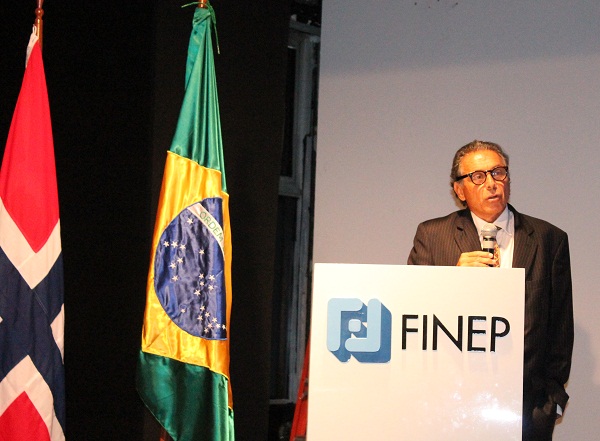The companies present at the workshop, that took place at the Espaco Finep in Flamengo om May 14-15, 2013, were all handpicked by Finep and Innovation Norway.
“Our ambition is to stimulate partnerships leading to technological development that Finep and Innovation Norway could support”, Ricardo Jabace, superintendent of financing at Finep, said in his opening remarks.
“The oil and gas segment is of great importance to Finep, and we are committed to support sectors that want to innovate, and in the case of Norway, we know that opportunities for technological cooperation are of the a great dimension. Finep can support Brazilian companies working with Norwegian partners and Norwegian companies that want to innovate in Brazil”, Mr. Jabace said.
Companies like Aker Solutions, Petrobras, Statoil, Alfatech, Odebrecht, Sintef, Resman and Marine Cybernetics participated at the workshop.
Rune Andersen from Innovation Norway gave a brief presentation on how the agency works, “like a combination of the Brazilian agencies Finep, BNDES and Sebrae”, according to Mr. Andersen.
“Our objective is to promote profitable business development throughout Norway, making Norwegian business competitive and encourage innovation and internationalization. This is especially important in the oil and gas sector. Our focus sectors in the Brazilian market is the oil and gas and maritime sectors, energy and environment.

Financing mechanisms
On day 2, Mr. Andersen talked about the financial instruments that Innovation Norway offers, in order to reduce risks of R&D projects in companies. Innovation Norway can finance projects in the pre-commercial development phase, until reaching the commercial phase. An evaluation shows that 44 percent of the projects that Innovation Norway has supported, are labelled commercial successes and 75 percent are labelled technological successes.
Mauricio Syrio talked about the financing mechanisms offered by Finep.
“We have resources for innovation and are waiting for the good projects. The more innovative, the better the conditions, and this is a global industry, so we need partnerships, and we find inspiration in the Norwegian experience, Mr. Syrio said.
Finep can finance up to 90 percent of the project value.
Tadeu Sant´Anna from the innovation agency IFES talked about the Subsea Index, a matchmaking tool for companies in the subsea industry, launched in 2012, and about the innovation poles localized at several universities in Espirito Santo.
“We work to create knowledge hubs in each country, business and innovations centers, or BICs, that work to solve technological challenges and improve products and processes demanded in the field of oil and gas”, he said
Siri Helle Friedemann from the Research Council of Norway and Tarjei N. Malme, program coordinator of the Norwegian Petromaks 2 research program, also presented several different research programs.
The Research Council of Norway is a key player in Norwegian research and adviser to the government. Focus areas in the oil and gas sector are environmentally sustainable technologies, increased recovery and cost-effective drilling.
“Norway is a small country and international cooperation is important to us. We need to go abroad to collaborate with the best”, Siri Helle Friedemann said.
According to Tarjei N. Malme, the Petromaks 2 program has an annual budget of 246 million NOK, about 85 million reais.
“Our objective is knowledge creation and industrial development, to promote optimal management of Norwegian petroleum resources within an environmentally sustainable framework, and we have common challenges with you in Brazil, and can co-finance projects with agencies or institutions from other countries. Only companies formally registered in Norway can apply, but they can have Brazilians partners in a consortium”, Mr. Malme explained.
Increased oil recovery
Representatives from Statoil and Petrobras presented what the two companies see as technological challenges.

Ole Petterson from Statoil RDI in Trondheim talked about the importance of the petroleum industry in Norway, which represents ¼ of the country´s GDP and employs 250.000 people. He also shared some key figures about Statoil, a company that currently produces 2 million boeds a day and is present in 37 countries.
“Our upstream strategy is to reach 2,5 million boeds a day by 2020, and we need new technology to achieve this. Within R&D, increased oil recovery (IOR) is the main focus for Statoil. We currently have a IOR rate of 50 percent, but the ambition is to reach 60 percent. We use half of the R&D budget on IOR, and you can say that IOR is the “largest field” on the Norwegian continental shelf”, Mr. Petterson said.
Statoil would also like to increase the recovery rate in Brazil,
“Our ambition within R&D in Brazil is driven by the corporate technology strategy. We want to be leading in seismic imaging and drill more cost-efficient wells. Statoil also wants to take subsea longer, deeper and colder. Focus areas are related to reservoirs as you have a lot of carbonate reservoirs here. Co2 management is another priority”, Mr. Petterson said.
Ronaldo Martins, relationship affairs manager from the procurement department of Petrobras, talked about the procurement policy of Petrobras and what is considered critical equipment supply.
According to Mr. Martins, exploring the pre-salt areas implies completely new technological challenges within drilling and completion, well integrity, reservoir characterization, increased recovery, flexible riser solutions, flow assurance and when it comes to mooring, interaction with riser systems and CO2 processing on FPSO-s. He talked about the local content requirements, but explained that in order to be considered a Brazilian company you need to be formally registered in Brazil. The origin of the company does not matter.
“Petrobras is planning to invest 236,7 billion USD the next 5 years in 947 projects. 770 are under implementation. There are all kinds of opportunities here, for those who understands what is required”, Mr. Martins said.
According to Petrobras´estimates, the company needs 2557 km of umbilicals, 423 wet christmas trees, 58 manifolds, 411 turbines, 178 cranes, 298 winches, 263 subsea wellheads, among other items, by 2017.
By Runa Hestmann Tierno, NBCC journalist
(runa.tierno@nbcc.com.br)
:


